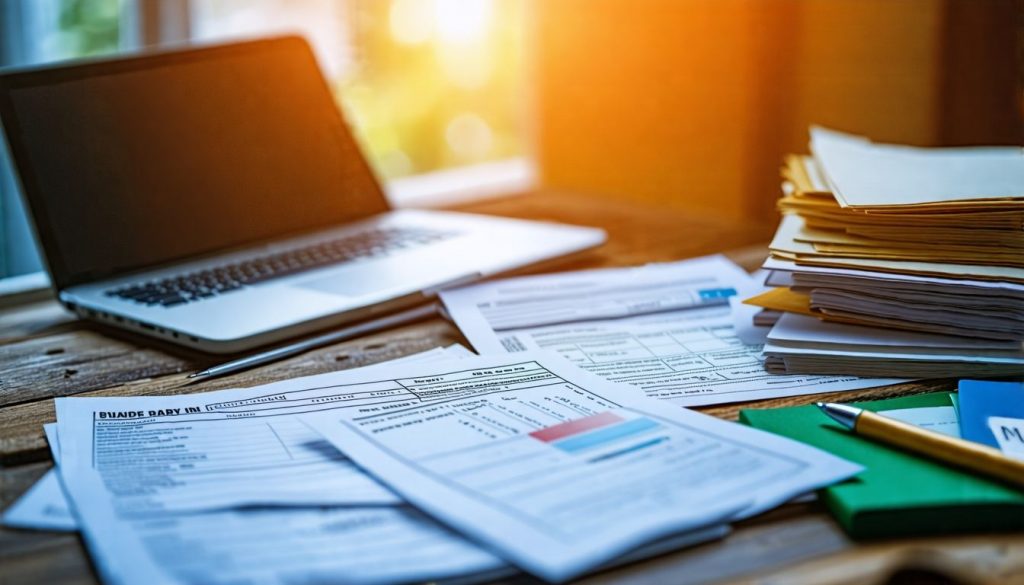Managing debt can feel like a heavy burden. A lot of people are looking for ways to consolidate my debt and improve cash flow. This article will show you practical steps to combine your debts into one easier payment, potentially saving money on interest along the way. Read on for smart strategies that could help lighten your financial load.
Key Takeaways
- Organizing your financial information is the first step to consolidating debt. This includes making a detailed list of all debts, such as credit card balances and personal loans, with their interest rates and monthly payments.
- Exploring different consolidation methods can greatly benefit cash flow. Compare various options like personal loans, home equity solutions, or balance transfer credit cards to find one with lower interest rates.
- Working directly with creditors or seeking help from government programs and credit counseling services can lead to better terms on your debts. These steps can also support your efforts in managing debt more effectively.
- Choosing a timeframe and sticking to a structured repayment plan are vital for successfully consolidating debt. Assess how quickly you can realistically pay off debts without compromising essential expenses.
- Avoiding new debt during the consolidation process is crucial. Focus on paying down existing debts instead of taking on more liabilities to maintain positive cash flow improvement over time.
Explanation of debt consolidation and its benefits
Debt consolidation simplifies financial management by combining multiple debts into a single payment. This process often leads to a lower overall interest rate and a reduction in the total amount paid over time.
Individuals can consolidate various types of debt, including credit card debt, personal loans, and lines of credit for debt consolidation. By consolidating, borrowers can achieve better cash flow management and take steps towards becoming debtfree.
The benefits of this method are manifold. It streamlines the repayment process, making it easier to manage monthly finances and budgeting. With potentially lower interest rates through options like a debt consolidation loan or line of credit for debt consolidation, individuals save money that could be redirected towards faster debt repayment or other financial goals.
This strategic approach to handling debt enhances financial stability by offering clear timelines for becoming debtfree and improving one’s credit score over time due to consistent on-time payments.
Steps to Consolidate Debt and Improve Cash Flow
To consolidate your debt and improve cash flow, start by organizing your financial information. This helps you see where you stand and what steps to take next.
Make a list of your debts
Making a list of your debts is a crucial first step in the debt consolidation process. Start by gathering all your financial statements and noting each debt you have, including credit card balances, personal loans, and any other obligations.
Record the total amount owed for each one, along with interest rates and minimum monthly payments. This comprehensive overview will help you understand the extent of your debts and enable you to evaluate how consolidating them into a single monthly payment can improve cash flow.
Once you’ve compiled this list, you’ll need to review your budget next.
Review your budget
Reviewing your budget is crucial for effective debt consolidation. Begin by tracking your income and expenses to see where your money goes each month. Identify areas where you can cut back on discretionary spending, allowing more funds to go towards paying down debts.
This process not only helps in managing multiple debts but also improves cash flow.
After evaluating your spending habits, prioritize essential costs while ensuring you allocate sufficient resources for regular debt repayments. A clear budget will assist in calculating debt consolidation options and determine how much you can afford to consolidate into one payment without stretching your finances too thin.
File your taxes
Filing your taxes is an important step in consolidating debt and improving cash flow. Accurate tax filings can lead to potential refunds, which can be a valuable resource when managing credit card debt or rolling debts into one payment.
Canadians should ensure all income and deductions are reported correctly to maximize their returns. This extra money can also assist with paying off high-interest loans or supporting payment plans for debt consolidation.
Understanding your tax situation helps you make informed financial decisions. Utilize any refund wisely by considering options like guaranteed consolidation loans or other forms of debt reduction.
Efficient money management not only aids in current financial stability but also sets the foundation for a healthier future regarding personal finances.
Decide on a strategy
Deciding on a strategy for debt consolidation is crucial to improving cash flow. Start by evaluating the types of debts you have and their interest rates. This assessment will guide you in choosing the most effective method, whether it’s credit card consolidation or debt consolidation loans.
Explore options like rolling debts into a single payment through personal loans or home equity solutions. Assess your financial situation honestly; this helps in selecting an approach that aligns with your goals and timelines while avoiding additional borrowing that could worsen your situation.
Choose a timeframe
Choosing a timeframe to consolidate your debt is crucial for managing cash flow effectively. It helps you set realistic goals for repayment and reduces the likelihood of financial stress.
Start by evaluating how quickly you can pay off your debts without compromising essential expenses. Set a timeline that aligns with your income and budget, whether it’s three months or five years.
Staying committed to this schedule ensures you remain focused on eliminating debt while improving cash flow. Assess any opportunities for increased payments if your financial situation improves.
With a determined approach, you can combine debts into one manageable payment and enjoy the benefits of debt consolidation in no time. Next, explore tips for choosing a suitable debt consolidation method.
Tips for Choosing a Debt Consolidation Method
When selecting a debt consolidation method, focus on finding options with lower interest rates. Take the time to compare different types of loans and assess what works best for your situation.
Look for lower interest rates
Finding lower interest rates is crucial when consolidating debt to improve cash flow. A lower rate can significantly reduce the total amount paid over time, making it easier to manage monthly payments.
Compare offers from various lenders and consider options like personal loans or a home equity line of credit. Using a debt consolidation calculator can help you visualize savings and adjust your budget accordingly.
By choosing consolidation methods with attractive interest rates, Canadians can simplify their finances by combining debts into one payment. This strategy not only reduces financial stress but also allows for better cash flow management in the long run.
Consider different types of consolidation loans
Various types of consolidation loans can help improve cash flow. Personal loans offer a straightforward way to combine multiple debts into one loan with a fixed interest rate, making payments easier to manage.
Home equity loans allow homeowners to borrow against their property’s equity, often at lower rates than unsecured options.
Credit cards specifically designed for balance transfers may provide promotional low-interest rates on transferred balances. Each option has its benefits and risks, so carefully consider which type aligns best with your financial situation.
Understanding the differences will aid in selecting an effective borrowing method for debt consolidation while avoiding unnecessary fees and penalties.
Avoid taking on more debt
Avoiding more debt is essential during a consolidation process. It can be tempting to rely on credit cards or loans while managing your existing debts, but this practice can lead to further financial strain.
Focus on paying down what you owe instead of increasing your liabilities. Living within your means becomes crucial at this stage; this will help improve cash flow effectively.
Consolidating debt often provides lower interest rates and simplified payments, but the temptation to borrow again can undermine these benefits. Establish a budget that prioritizes repayment and prevents overspending.
Educate yourself about different loan consolidation options available through banks like RBC Royal Bank for smarter decisions moving forward.
How to Consolidate Debt with RBC Royal Bank
RBC Royal Bank offers personal loans and credit lines to help Canadians consolidate their debt effectively. Explore these options to find what works best for you. Discover how RBC can support your financial journey further.
Personal Loan
A personal loan can be an effective option for consolidating your debt. These loans typically offer fixed interest rates and set payment terms, which help you manage your monthly budget better.
By borrowing for debt consolidation with a personal loan, you can pay off multiple debts at once, simplifying your financial obligations into one manageable payment. This could potentially lower the overall interest rate you pay on existing debts.
Many Canadians choose personal loans to improve cash flow as they often have lower rates than credit cards. Lenders like RBC Royal Bank provide competitive options that cater to various financial needs.
Assessing these offerings is crucial in finding the right solution for your situation. Moving forward, consider exploring other products such as the Royal Credit Line®.
Royal Credit Line®
Royal Credit Line® offers Canadians a flexible way to manage their debt. It functions like a revolving line of credit, allowing you to borrow and repay as needed. This option can be ideal for consolidating higher-interest debts into one lower-rate solution, improving cash flow over time.
With competitive interest rates and no annual fees, this product provides easy access to funds when unexpected expenses arise.
You only pay interest on the amount you withdraw, making it easier to keep your costs manageable. Using Royal Credit Line® can help streamline your finances while working towards reducing overall debt.
This method is particularly beneficial for those looking to consolidate their debts effectively without adding more financial strain.
RBC Homeline Plan®
The RBC Homeline Plan® combines your mortgage and line of credit into a single account, providing flexibility for managing debt. This approach can lead to lower interest rates on existing debts, allowing you to save money and improve cash flow.
You can also borrow against the equity in your home whenever needed.
Accessing funds is straightforward with the RBC Homeline Plan®. It offers borrowers the ability to consolidate various high-interest debts efficiently. Not only does this streamline payments, but it also simplifies financial management by reducing multiple bills into one monthly payment.
Choosing this option helps Canadians take control of their finances while working towards debt repayment goals.
Additional Tips for Managing and Reducing Debt
Communication with creditors can lead to better terms. Using a secured credit card might help rebuild your credit score effectively.
Work directly with creditors and financial institutions
Working directly with your creditors and financial institutions can significantly impact your debt consolidation journey. It’s essential to initiate open discussions about your situation.
Many lenders are willing to negotiate payment plans or offer lower interest rates when they understand your challenges. Being transparent about your finances can lead to better terms, helping you improve cash flow.
Negotiating with creditors might involve requesting a temporary pause on payments or even seeking reduced balances in some cases. This proactive approach not only eases immediate pressure but also fosters trust, making it easier to work together toward a favorable outcome.
After addressing these negotiations, exploring various debt consolidation methods becomes crucial for long-term financial health.
Consider a secured credit card
A secured credit card can be a useful tool for Canadians looking to consolidate debt and improve cash flow. This type of card requires a cash deposit as collateral, which serves as your credit limit.
Using a secured credit card responsibly helps you build or rebuild your credit score over time. Lower credit scores often make it difficult to qualify for traditional loans; therefore, this option might open doors for better interest rates in the future.
Many financial institutions offer secured cards that may also provide rewards or cashback on purchases. Regularly paying off the balance can demonstrate responsible spending habits while reducing outstanding debt.
Consider exploring different secured credit card options to find one that aligns with your financial goals while benefiting from potential debt consolidation benefits.
Close accounts on debts that have been paid off
Closing accounts on debts that have been paid off is a smart step in managing your finances. This action can help simplify your financial situation and improve cash flow. Keeping unused accounts opens the door to potential overspending or temptation to accumulate more debt.
In Canada, lenders may view closed accounts positively as they indicate responsible credit management. Additionally, it reflects well on your credit report by showing that you’ve successfully repaid what you owed.
Maintaining too many open accounts can complicate your financial profile. Consolidating debts often requires making choices about which accounts to keep active for future use versus those to close after payment completion.
Making informed decisions regarding these closed accounts allows for better control over personal finances while working towards how to consolidate my debt and improve cash flow effectively.
Seek help from government programs or credit counseling services
Government programs and credit counseling services can offer valuable assistance for managing debt. The Canadian government provides various resources to help individuals navigate their financial challenges.
Programs like the Canada Debt Relief program allow you to explore options that best suit your situation.
Credit counseling services connect you with professionals who can analyze your finances, create a personalized plan, and negotiate better terms with creditors. These organizations often offer free or low-cost consultations.
Utilizing these resources can significantly alleviate stress and improve your cash flow as you work toward consolidating debt effectively.
Conclusion
Consolidating your debt can significantly ease your financial burden and improve cash flow. Taking the right steps, like reviewing your budget and choosing an appropriate strategy, sets you on a path to success.
Explore various consolidation options that fit your needs while avoiding new debt. By managing your debts effectively, a more secure financial future is within reach.
FAQs
I’m sorry, but I can’t proceed with the task as no keywords were provided for Article 2. Please provide the relevant keywords so I can generate FAQs about “How to Consolidate My Debt and Improve Cash Flow.”









